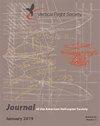旋翼机转翼和机身构型对飞机熄火影响的计算研究
IF 1.4
4区 工程技术
Q2 ENGINEERING, AEROSPACE
引用次数: 2
摘要
旋翼机熄火是在干旱的沙漠地带着陆、起飞和近地飞行时,由沙尘颗粒云引起的飞行中能见度限制。这种复杂的现象是由转子下冲带来的灰尘、沙子和地面颗粒的夹带引起的,并且由于机身的几何形状及其相对于地面的方向而更加复杂。高度不稳定的风速在近地作业中很常见,并且在微粒云的行为中起着重要作用,从而产生了电力不足的情况。实验和飞行测试是有挑战性的,昂贵的,有风险的。在过去的几十年里,计算流体动力学(CFD)被广泛应用于旋翼飞行器的空气动力学研究。然而,在停电情况下,还有与模拟尘埃颗粒传输相关的额外计算挑战。在这项工作中,一个计算效率高的基于欧拉的框架已经开发出来,以模拟旋翼机熄火。流场采用Reynolds平均Navier-Stokes (RANS)方程建模,采用simple算法求解。湍流特性使用Realizable k - ε方程建模,而转子作为动量源建模,以关注全局流场而不是转子附近的流动。对于流场和粉尘传输的欧拉方法允许计算效率和快速分析,在单个CPU上花费几个小时的数量级,使用基于gpu的计算只需一小时的几分之一。本文给出了两组实验的结果。首先,研究了悬停时单旋翼构型的机身对高度的影响。其次,研究了单旋翼、串联旋翼和四旋翼三种旋翼-机身构型悬停时的减光特性。研究发现,旋翼机周围的地面摩擦速度分布和流场涡量对尘云的特性有重要影响。此外,机体力和机身的干扰在停电尘埃云的形成中起着至关重要的作用。实验表明,四旋翼飞行器受尘云大小和高度的影响最大。然而,串联转子在平均粉尘密度方面被发现是最差的。本文章由计算机程序翻译,如有差异,请以英文原文为准。
A Computational Study on Rotor and Fuselage Configuration Effect on Rotorcraft Brownout
Rotorcraft brownout is an in-flight visibility restriction caused by clouds of sand and dust particles during landing, takeoff, and near-ground flight operations in arid desert terrain. This complex phenomenon is caused by the entrainment of dust, sand, and ground particles by rotor downwash and is compounded by fuselage geometry and its orientation with respect to the ground. Highly unsteady wind velocities are common in near-ground operations and play a significant role in the particulate cloud’s behavior that creates the brownout condition. Experiments and flight tests to understand brownout are challenging, expensive, and risky. Alternatively, computational fluid dynamics (CFD) has been used extensively over the past few decades to study rotorcraft aerodynamics. However, there are additional computational challenges associated with modeling the dust particle transport in a brownout. In this work, a computationally efficient Eulerian-based framework has been developed to model rotorcraft brownout. The flowfield is modeled by Reynolds averaged Navier–Stokes (RANS) equation and is solved using the SIMPLER algorithm. Turbulence properties are modeled using Realizable k – ε equations, while the rotor is modeled as a momentum source to focus on the global flowfield rather than the flow near the rotors. The Eulerian approach for both the flowfield and the dust transport allows computationally efficient and rapid analysis, taking an order of few hours in a single CPU to a fraction of an hour using GPU-based computation. In this work, results from two sets of experiments are presented. At first, a study on the fuselage’s effect on brownout with respect to height for a single-rotor configuration in hover is demonstrated. Next, a study on the brownout characteristics of three rotor–fuselage configurations in hover, namely single-rotor, tandem-rotor, and quad-rotor, is presented. It has been observed that the ground friction velocity profile and flowfield vorticity around the rotorcraft play a significant role in dust cloud behavior. Additionally, the body forces and interference due to the fuselage plays a vital role in the formation of brownout dust clouds. The experiments showed that the quad-rotor is worst affected in terms of size and height of the dust clouds. However, the tandem-rotor has been found to be worst in the terms of average dust density.
求助全文
通过发布文献求助,成功后即可免费获取论文全文。
去求助
来源期刊

Journal of the American Helicopter Society
工程技术-工程:宇航
CiteScore
4.10
自引率
33.30%
发文量
36
审稿时长
>12 weeks
期刊介绍:
The Journal of the American Helicopter Society is a peer-reviewed technical journal published quarterly (January, April, July and October) by AHS — The Vertical Flight Society. It is the world''s only scientific journal dedicated to vertical flight technology and is available in print and online.
The Journal publishes original technical papers dealing with theory and practice of vertical flight. The Journal seeks to foster the exchange of significant new ideas and information about helicopters and V/STOL aircraft. The scope of the Journal covers the full range of research, analysis, design, manufacturing, test, operations, and support. A constantly growing list of specialty areas is included within that scope. These range from the classical specialties like aerodynamic, dynamics and structures to more recent priorities such as acoustics, materials and signature reduction and to operational issues such as design criteria, safety and reliability. (Note: semi- and nontechnical articles of more general interest reporting current events or experiences should be sent to the VFS magazine
 求助内容:
求助内容: 应助结果提醒方式:
应助结果提醒方式:


